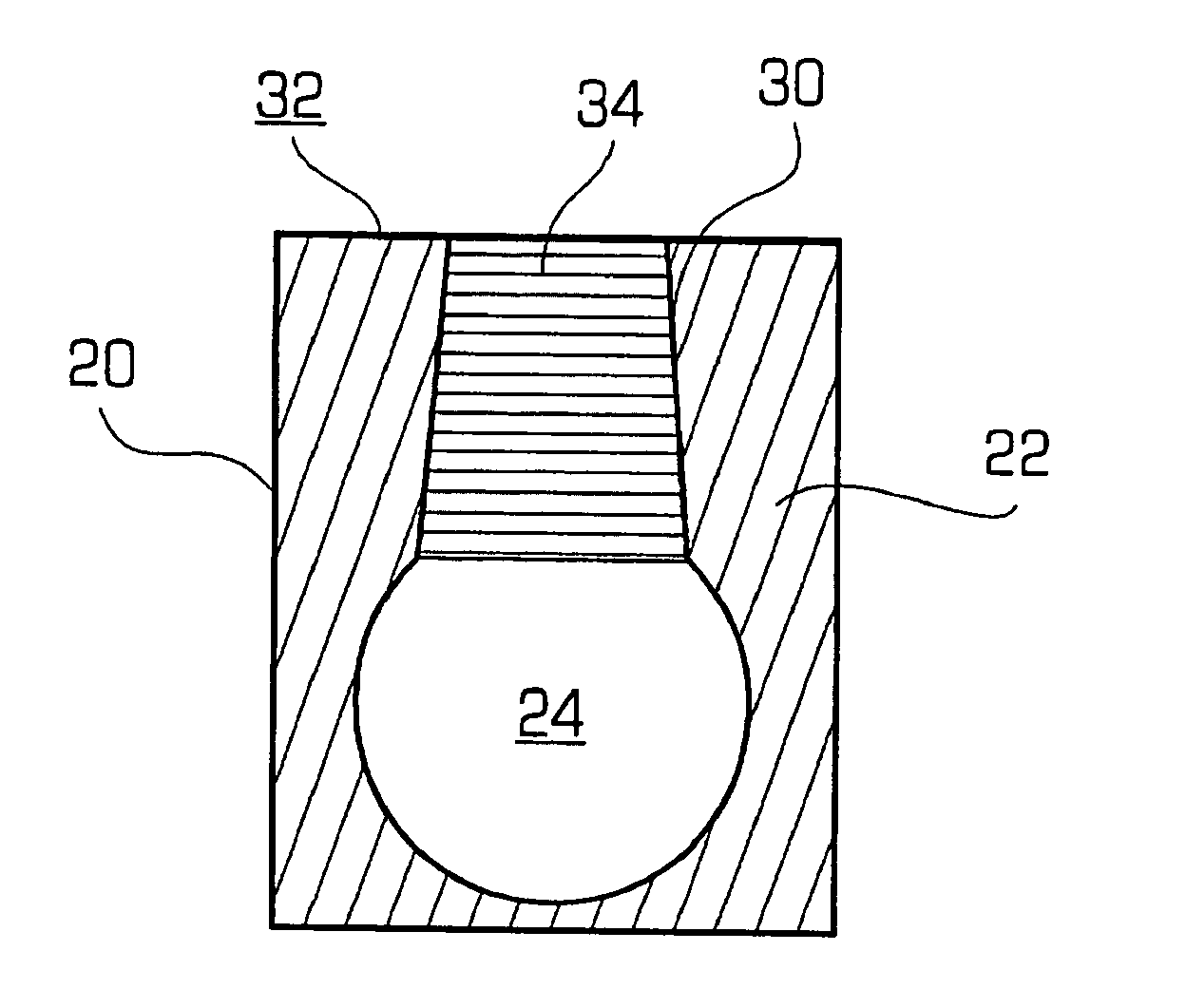High intensity plasma lamp
a plasma lamp and high-intensity technology, applied in the direction of electric discharge lamps, basic electric elements, electrical appliances, etc., can solve the problems of bulb failure, deterioration and erode, short-arc lamps that have not tended to be long-lived, etc., and achieve unprecedented operating life expectancy
- Summary
- Abstract
- Description
- Claims
- Application Information
AI Technical Summary
Benefits of technology
Problems solved by technology
Method used
Image
Examples
first embodiment
[0025]FIG. 1 shows an improved light source in accordance with the invention. The light source may be a plasma lamp comprising a gas housing 20 preferably formed from a ceramic material 22, as will be described below, with an interior cavity or chamber 24 for containing gas. The housing may generally be rectilinear or cubic, and the chamber may be spherical. A channel 30 may connect the chamber to an exterior surface 32 of the housing. The channel 30 may be made of light transmissive material, preferably of sapphire in order to form a window 34 for emitting visible light from the chamber. The window preferably has a generally tapered, conical shape; i.e., a frusto-conical shape. The sapphire window seals the chamber to contain the gas, while affording an exit for the light produced by the plasma discharge.
[0026]Sapphire is preferred for the window since it is less gas permeable than quartz, for example, and better withstands the heat cyclings and high temperatures associated with la...
second embodiment
[0031]FIG. 2 shows a lamp in accordance with the invention which is somewhat similar to FIG. 1 except that the gas housing has an integrated RF energy structure. In FIG. 2, the elements are designated similarly to FIG. 1, using like reference numerals for like elements. The gas fill chamber 24 may be housed in a gas housing 20 preferably comprising a ceramic material 22 and provided with a light transmissive window 34, preferably of a tapered rod of sapphire and a fill plug 38 as previously described. In this embodiment, an RF energy structure such as one or more coils 36 may be formed within the ceramic housing. The coils 36 function to inductively couple radio wave radiation energy to the gas fill in chamber 24 in order to create the plasma discharge. In this way, the RF structure of the plasma lamp that is active with radio wave energy is integral with the ceramic housing 20 that contains the plasma gas fill. This integration of the RF structure of the plasma lamp and the gas hou...
third embodiment
[0033]FIG. 3 shows a lamp in accordance with the invention which integrates both the gas housing and an RF energy source within the same structure. A gas housing 50 for the gas fill may be formed so as to be integral with a waveguide 52 which preferably comprises a ceramic structure having a substantially rectangular cross-section. Because no separate bulb is used, the housing 50 and waveguide 52 comprise a single, integrated structure. A source of radio wave radiation 54 may be disposed within the ceramic structure, for example, near one end of the waveguide. The RF source 54 may be an RF antenna, a probe, or the like for introducing RF energy into the waveguide. The gas housing 50 may be located near the other end of the waveguide, for example. As shown, the gas housing may further include a light transmissive window 56 connected to the end wall of the housing. The window is preferably made from sapphire.
[0034]The dimensions of the waveguide and the locations of the RF source and ...
PUM
 Login to View More
Login to View More Abstract
Description
Claims
Application Information
 Login to View More
Login to View More - R&D
- Intellectual Property
- Life Sciences
- Materials
- Tech Scout
- Unparalleled Data Quality
- Higher Quality Content
- 60% Fewer Hallucinations
Browse by: Latest US Patents, China's latest patents, Technical Efficacy Thesaurus, Application Domain, Technology Topic, Popular Technical Reports.
© 2025 PatSnap. All rights reserved.Legal|Privacy policy|Modern Slavery Act Transparency Statement|Sitemap|About US| Contact US: help@patsnap.com



